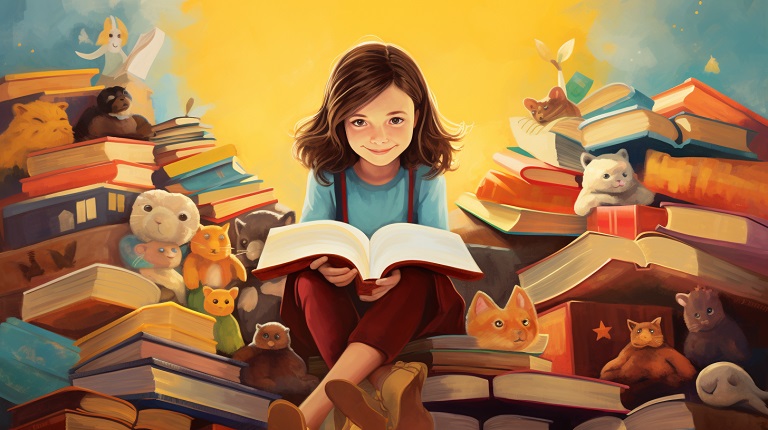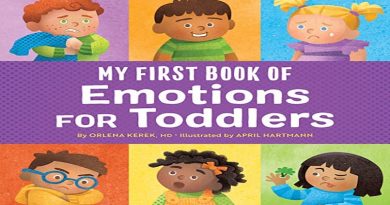The Surprising Ways Children’s Books Can Foster Imagination and Creativity
Children’s books have long been cherished for their ability to spark imagination and creativity in young minds. But did you know that the impact of these books goes beyond just entertainment? Recent research has revealed the surprising and profound ways in which children’s books can foster imagination and creativity. In this blog post, we will explore the various reasons why children’s books are invaluable tools for nurturing these essential skills in children. From developing problem-solving abilities to honing language skills, the benefits of reading children’s books are far-reaching and cannot be underestimated. So, if you’re a parent, teacher, or anyone interested in the growth and development of children, this article is for you! Get ready to delve into the fascinating world of children’s books and discover how they unlock the limitless potential of a child’s imagination.
The impact of descriptive language in children’s books
The impact of descriptive language in children’s books is far-reaching and profound. Through vivid language and evocative imagery, these books have the power to transport young readers to magical worlds and ignite their imagination. By introducing children to descriptive words and phrases, authors not only entertain, but also inspire creativity and stimulate empathy. For instance, when a character in a book is described as having “sparkling blue eyes” or a “mischievous grin,” it allows children to visualize and connect with the story on a deeper level, fostering their capacity for imaginative thinking.
Additionally, descriptive language in children’s books serves as a valuable tool for language development. By including rich descriptions of people, places, and events, authors expose young readers to a broader vocabulary and enhance their ability to communicate and express themselves. Through encounters with new words like “majestic,” “whispering,” or “gigantic,” children’s books expand their linguistic repertoire and promote the development of their reading and writing skills. Moreover, descriptive language in stories encourages children to think critically and interpret the meaning behind the words, ultimately nurturing their analytical thinking abilities.
Beyond language skills, descriptive language in children’s books also plays a crucial role in cultivating empathy and emotional intelligence. By vividly describing characters’ emotions and experiences, authors enable young readers to step into their shoes and gain a deeper understanding of different perspectives and emotions. When children encounter characters who feel scared, excited, or sad, they learn empathy and develop the ability to recognize and relate to these emotions in themselves and others. This emotional connection not only enriches their reading experience but also fosters compassion and a sense of understanding towards others.
Exploring the Role of Imagination in Children’s Books
Children’s books have always held a special place in the hearts of both kids and adults alike. They not only entertain, but they also have the power to inspire and foster imagination and creativity in young minds. The colorful illustrations, whimsical characters, and captivating stories found in these books open up a world of possibilities for children to explore.
Imagination plays a crucial role in children’s development. Through the pages of these books, children can envision themselves as brave adventurers, clever problem solvers, or even magical beings. They learn to think outside the box and explore new ideas, helping to develop their creativity and innovation skills.
Moreover, the role of imagination in children’s books goes beyond individual development. It also fosters empathy and understanding towards others. As children immerse themselves in different stories and encounter diverse characters, they learn to see the world from different perspectives. This not only promotes inclusivity but also nurtures their social and emotional intelligence.
Thanks to the incredible power of imagination in children’s books, kids can explore the depths of their creativity in a safe and magical way. These stories hold the potential to shape young minds, ignite their passions, and sow the seeds for a generation of innovative individuals. So, let’s continue to celebrate and cherish the role of imagination in children’s books, nurturing the bright minds and colorful dreams of the future.
How children’s books can help to create a world of make-believe
Children’s books have always been cherished for their ability to transport young readers to magical realms and inspire their imagination. Whether it’s a tale about brave knights and fairies or a story centered around talking animals, these books have the power to create a captivating world of make-believe. Through vivid illustrations and compelling narratives, children’s books encourage creativity and foster the ability to think outside the box. They provide a safe space for children to explore their imagination and dive into fantastic adventures.
One surprising way children’s books fuel imagination and creativity is by introducing them to new ideas and perspectives. These stories often feature diverse characters and tackle various themes, helping children develop empathy and a broader understanding of the world around them. By immersing themselves in the lives of different characters, young readers can gain a deeper appreciation for different cultures, experiences, and ways of thinking. This exposure to diverse narratives fosters a sense of openness and encourages children to think creatively and outside their own perspective.
Another remarkable aspect of children’s books is their ability to stimulate problem-solving skills. Many stories revolve around characters who face challenges and obstacles, encouraging young readers to use their imagination and come up with innovative solutions. This process helps children build critical thinking skills and develop their problem-solving abilities, which are crucial for their future success. By engaging with these stories, children learn that there is always a way to overcome challenges and that their imagination holds endless possibilities.
In a world increasingly dominated by screens and digital distractions, children’s books offer a welcome break and provide children with the opportunity to unplug and engage with their creative side. By encouraging a love for reading, these books can inspire children to become lifelong learners and thinkers. They create a safe and exciting space where kids can let their imagination run wild, fostering a love for stories and nurturing their creative potential. So, next time you pick up a children’s book, remember the surprising ways it can ignite a world of make-believe and unlock the limitless power of a child’s imagination.
Uncovering the Magic of Storytelling
A well-crafted children’s book can transport young readers to enchanting worlds that evoke imagination and creativity, allowing them to get lost in a story for hours. In this fast-paced, technological world, it’s easy to forget the simple pleasure of getting lost in a story. From colorful illustrations to whimsical characters, these books hold the power to captivate curious minds and ignite their imaginations.
Within the pages of children’s books lies a world of untapped potential. As young readers follow the journey of brave adventurers, wise animals, and endearing heroes, their own creativity takes flight. With each turn of the page, children uncover new ideas, perspectives, and possibilities. They become the architects of their own magical worlds, dreaming up imaginative tales and fostering a love for storytelling that will last a lifetime.
But the magic of children’s books doesn’t stop at sparking creativity. These literary treasures also teach important life lessons. Through relatable characters and meaningful narratives, stories help children navigate their emotions, learn empathy, and develop a sense of self. They discover the power of resilience, friendship, and kindness, all while being entertained and inspired.
Parents and educators alike recognize the invaluable role children’s books play in nurturing imagination and creativity. By encouraging young readers to explore these captivating tales, we are unlocking a world of endless possibilities, inspiring the next generation of dreamers, thinkers, and storytellers. So let us celebrate the joy of reading, and embark on a whimsical journey together, where the magic of storytelling continues to weave its spell.
The importance of storytelling in fostering creativity
Storytelling has always been a powerful tool for fostering creativity in children. From the earliest age, children are captivated by stories and the imaginary worlds they create. Whether it’s a classic fairy tale or a modern adventure, children’s books have a unique ability to ignite their imaginations and inspire them to think outside the box. By immersing children in a world of imagination and wonder, storytelling helps to foster their creativity and enable them to explore new ideas and possibilities.
One of the surprising ways that children’s books foster creativity is by encouraging imaginative thinking. As children immerse themselves in the stories they read, they are transported to new worlds and introduced to characters and situations they may never have encountered before. This exposure to different perspectives and ideas encourages children to think creatively and helps them build their own unique perspectives on the world. They begin to ask questions, make connections, and come up with their own stories and ideas, fueling their creative thinking skills.
Another way that children’s books foster creativity is by fostering a love for reading and learning. When children are excited and engaged by the books they read, they are more likely to develop a lifelong love for reading. This love for reading goes hand in hand with a thirst for knowledge and a desire to learn. As children explore different books and genres, they are exposed to new ideas, cultures, and perspectives. This exposure to different worlds broadens their horizons and encourages them to think creatively and explore new possibilities.
The importance of storytelling in developing a child’s creativity cannot be overstated. By immersing them in a world of imagination and wonder, children’s books ignite their imaginations and inspire them to think creatively. They encourage imaginative thinking, help children develop a love for reading and learning, and expose them to new ideas and perspectives. By embracing the power of storytelling, we can nurture creativity in the next generation and help them reach their full creative potential.
Conclusion
The power of children’s books to foster imagination and creativity should not be underestimated in a world full of screens and instant gratification. There is so much more to these humble works of literature than entertainment; they are the keys to uncharted mental territories and endless possibilities. By immersing our children in the realms of fantasy and fiction, we gift them with the ability to envision worlds beyond their own, to think critically and explore innovative ideas. As parents and caretakers, it is our duty to provide the next generation with the tools they need to thrive in an ever-evolving world. So, let us embrace the magic of children’s books and unlock the imagination within. Let us be the catalysts for a generation of dreamers, innovators, and creators, for the future lies in their hands.












